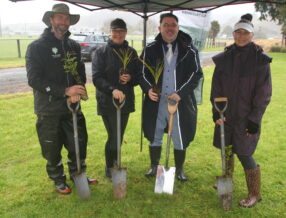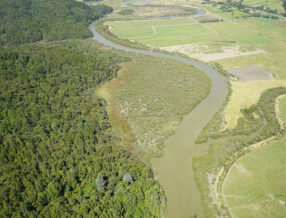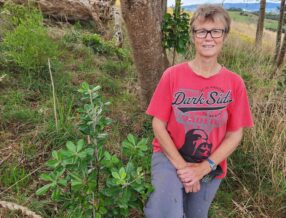November 15, 2023
The People behind KMR – Johnny and Jordan Hildreth – Woodhill
The father and son team of Johnny and Jordan Hildreth have a clear plan for protecting waterways, wetlands and steeper hillsides on their Woodhill Farm.
They have teamed up with the Kaipara Moana Remediation programme to fence selected areas of their 200-hectare sheep and beef unit.
Johnny initially leased the land from his father Peter before buying the 140ha home block in 1986. He purchased a neighbouring 60ha farm in in the early 2000s and has been caring for the land since – more recently with the help of his son Jordan.
They now run 300 Romney cross breeding ewes, trade 500 to 1000 lambs and run 200-300 cattle.
That is why the pair were keen to align with the Kaipara Moana Remediation programme because they see the value of helping protect the Kaipara Moana by fencing off waterways and wetlands and planting them in natives – while at the same time benefitting their farm.
For now, they are reflecting on what they have achieved in 2023, which includes planting 2000 mānuka trees gifted to them by Comvita, a third-party commercial co-investor partnering with KMR, plus 800 that they paid for personally. Jordan says they even shared some of the mānuka with their neighbour to help get them on the environmental journey.
“In 2022 we planted 4500 trees and put in 250 metres of new fence line, while in late 2023 they will put in a further 200m of fencing in readiness for the 2024 planting season.
They have also mapped out a plan to retire areas of steeper, less-productive hillsides and those efforts could begin later in 2024 (with at least 400m of new fencing), ready for native planting from 2025 and beyond.
Johnny says they have identified more areas around the farm (totalling 10ha), which they would love to fence off and plant as finances allow.
His goal is to have any areas of the farm too steep to drive a tractor on because he believes dirt and nutrients are running off that steeper land, ultimately into waterways.
“When Poppa broke in the farm, he clearly had a bit of an environmental bent because he did not open up everything in search of every blade of grass,” says Jordan.
“With our KMR partnership we are focussing on medium plantings and locking up gullies and waterways to go with 45ha of native bush already fenced off, plus the 16ha of a former pine tree block where we replanted with 10,000 mānuka after harvest in 2019.”
The father/son partnership say the way their river flats keep flooding so frequently, there could be merit one day in putting some of that land back into kahikatea and other natives, as they once used to be.
They did exactly that with Auckland Council’s ‘Trees for Survival’ programme in conjunction with one Auckland primary and an Auckland secondary school in 2017, when they planted natives along the banks of the Kaipara River which runs through the property. Those plants are now thriving and are clearly visible from State Highway 16.
Jordan says the KMR planting rates recommended for hillsides and slips of around 2500-4000 plants per ha, and up to 9000 plants per ha for wetlands and waterways makes sense.
Says Johnny: “If you have good people driving a programme like KMR it makes all the difference, especially for people like Jordan and I because we simply don’t have the time to achieve what we are with KMR’s help and advice. Being in communication with people who are interested in the environment means problems are easily solved.”
“We are setting the scene now for what is to come. Nibbling away at fencing and planting gets the ball rolling and we would love to see all of our river planted. As farmers, if you can get this wort of activity up your priority list for spending money and afford it, just do it.
Jordan and Johnny say they are thrilled with the KMR programme and are looking forward to doing more work together.




